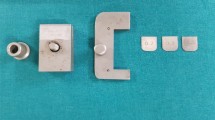Abstract
Tympanic Membrane perforation is a common cause of hearing loss. Various surgical techniques with different types of graft materials have been described for the treatment of perforations. The conchal cartilage and temporalis fascia graft are most widely used. We conducted a prospective Randomized control trial at Sri Guru Ram Das Institute of Medical Sciences and Research to compare the post operative hearing outcomes between the patients of safe CSOM (n = 40) using temporalis fascia (n = 20) and conchal cartilage (n = 20). It was found that the AB gap closure at 2 months post-operatively was 11.55 ± 8.173 for conchal perichondrium group as compared to 10.49 ± 9.069 for temporalis fascia group. At 6 months the AB gap closure was 14.98 ± 9.915 for conchal cartilage group as compared 11.41 ± 8.288 db for temporalis fascia group. Thus hearing improvement was better for conchal cartilage group both at 2 and 6 months but the comparison of the AC gain at the end of 6 months and subjective improvement in hearing between the two techniques was not statistically significant owing to the small sample size of the study. Both Temporalis fascia and conchal cartilage with perichondrium were acceptable graft material for successful closure of tympanic membrane perforation, hearing improvement was better with conchal cartilage group.



Similar content being viewed by others
References
Rizer FM (1997) Tympanoplasty: a historical review and a comparison of techniques. Laryngoseope 107(84):1–25
Heerrnann H (1960) Tympanic membrane plastic with temporal fascia. Hals Nas Ohren 9:136–139
Shea JJ (1960) Vein graft closure of eardrum perforations. J Laryngol Otol 74:358–362
Mreobrazhenski TB, Rugov AA (1965) The employment of preserved dura mater graft in tympanoplasty. Vestn Otorinolaringol 5:38–42
Wullstein HL (1952) Funktionelle operationen im mettelohr mit Hilfe des Freien Spaltlappentransplantates. Arch Otorhinolaryngol 161:422–435
Zoellner F (1955) The principles of plastic surgery of the sound conducting apparatus. J Laryngol Otol 69:657–659
Kaeker SK (1976) Suggestions for improving result in myringoplasty. Indian J Otolaryngol 28:73–75
Kumarsean M (1986) Vascular myringoplasty. Indian J Otolaryngol 38(4):127
Quareshi MS, Jones NS (1995) Day case myringoplasty using tragal periehondrium. Clin Otolaryngol Allied Sci 20(1):12–14
Buckingham RA (1992) Fascia and perichondrium atrophy in tympanoplasty and recurrent middle ear atelectasis. Ann Otol Rhinol Laryngol 101:755–758
Duckert LG, Muller J, Makielski KH, Helms J (1995) Composite autograft “shield” reconstruction of remnant tympanic membranes. Am J Otol 16:21–26
Yamamoto E, Iwanaga M, Fukumoto M (1988) Histologic study of homograft cartilage implanted in the middle ear. Otolaryngol Head Neck Surg 98:546–551
Hamcd M, Samir M, El Bigcrmy M (1999) Fate of cartilage material used in middle ear surgery light and electron microscopy study. Auris Nasus Larynx 26:257–262
Shechy JL, Anderson RG (1980) Myringoplasty. A review of 472 cases. Ann Otol Rhinol Laryngol 89:331–334
Hartwein J (1992) “crown-cork tympanoplasty” a method complete reconstruction of tympanic membrane. Laryngor-Hinootogies 71(2):102–104
Zahnert T, Huttenbrink KB, Murbe D, Bornitz M (2000) Experimental investigations of the use of cartilage in tympanic membrane reconstruction. Am J Otol 21:322–328
Chen XW, Yang H, Gao RZ, Yu R, Gao ZQ (2010) Perichondrium/cartilage composite graft for repairing large tympanic membrane perforations and hearing improvement. Chin Med J 123(3):301–304
Zhang ZG et al (2011) Three autologous substitutes for myringoplasty: a comparative study. Otol Neurotol 32:1234–1238
Labatut Pesce T, Granon S, Mora Rivas E, Madrid CM (2009) Primary myringoplasty results, 2 year follow up. Acta Otorhinolaryngol Esp 60(2):79–83
Author information
Authors and Affiliations
Corresponding author
Rights and permissions
About this article
Cite this article
Bhardwaj, B., Singh, J. Comparative Study of Hearing Improvement of Type 1 Tympanoplasty Using Temporalis Fascia and Conchal Cartilage as Graft Material. Indian J Otolaryngol Head Neck Surg 71 (Suppl 2), 1174–1178 (2019). https://doi.org/10.1007/s12070-018-1248-0
Received:
Accepted:
Published:
Issue Date:
DOI: https://doi.org/10.1007/s12070-018-1248-0




